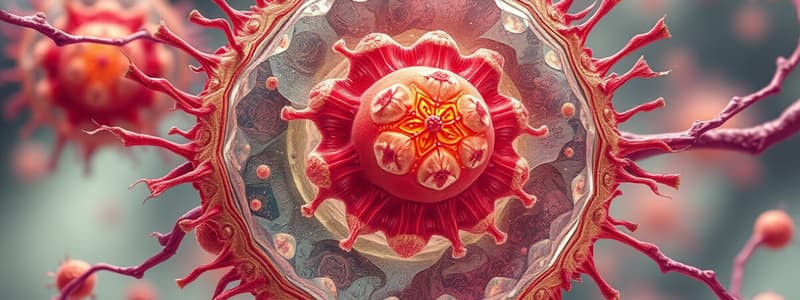Podcast
Questions and Answers
What distinguishes prokaryotic cells from eukaryotic cells?
What distinguishes prokaryotic cells from eukaryotic cells?
Prokaryotic cells lack a nucleus and membrane-bound organelles, while eukaryotic cells contain a nucleus and complex organelles.
What is the significance of the nucleoid in prokaryotic cells?
What is the significance of the nucleoid in prokaryotic cells?
The nucleoid is the region in prokaryotic cells where the single chromosome is located, directly in contact with the cytoplasm.
How do the sizes of prokaryotic cells compare to eukaryotic cells?
How do the sizes of prokaryotic cells compare to eukaryotic cells?
Prokaryotic cells are generally much smaller, ranging from 0.5 to 2.0 µm in diameter, while eukaryotic cells are typically about fifteen times wider.
What are some examples of unicellular organisms, and how do they differ from multicellular organisms?
What are some examples of unicellular organisms, and how do they differ from multicellular organisms?
What role does the cytoskeleton play in eukaryotic cells?
What role does the cytoskeleton play in eukaryotic cells?
What are the main functions of epithelial tissue and how are its cells characterized?
What are the main functions of epithelial tissue and how are its cells characterized?
Describe the composition and functions of blood as a type of connective tissue.
Describe the composition and functions of blood as a type of connective tissue.
What role does cartilage play in the skeletal system and what is its defining characteristic?
What role does cartilage play in the skeletal system and what is its defining characteristic?
Differentiate between the types of muscle tissue found in vertebrates and their functional characteristics.
Differentiate between the types of muscle tissue found in vertebrates and their functional characteristics.
How do the arrangements of epithelial cells support their specific functions?
How do the arrangements of epithelial cells support their specific functions?
Flashcards are hidden until you start studying
Study Notes
Cells Overview
- Fundamental unit of life; all living organisms consist of cells.
- Organisms classified as unicellular (single-celled) or multicellular (multiple cells).
- Unicellular examples: Bacteria, Archaea, Protozoa.
- Multicellular examples: Plants, Animals, Algae, and Fungi.
Classification of Cells
- Two primary cell types:
- Prokaryotic Cells: Lack a nucleus and membrane-bound organelles; examples include Bacteria and Archaea.
- Eukaryotic Cells: Contain a nucleus and several membrane-bound organelles.
Prokaryotes
- First life forms on Earth, characterized by simplicity and small size (0.5 to 2.0 µm in diameter).
- DNA is a single chromosome in direct contact with cytoplasm, found in nucleoid region.
- No membrane-bound organelles present.
Eukaryotes
- More complex cells with organized internal structures, such as membranes and a cytoskeleton.
- Characterized by the presence of a nucleus; typically larger (up to fifteen times wider than prokaryotes).
- Eukaryotic DNA organized into linear chromosomes associated with histone proteins.
- Most chromosomal DNA is stored in the nucleus; some organelles (e.g., mitochondria) also contain DNA.
Types of Cell Tissues
- Four main tissue types:
- Epithelial
- Connective
- Muscle
- Nervous
Epithelial Tissue
- Forms coverings or linings of organs and cavities; characterized by tightly joined cells with tight junctions.
- Tight junctions provide barriers against pathogens and fluid loss.
- Distinct arrangements of epithelial cells:
- Cuboidal: secretion
- Simple columnar: secretion and active absorption
- Simple squamous: material exchange through diffusion
- Stratified squamous: multilayered, regenerates quickly for protection.
Connective Tissue
- Comprised of loose and fibrous connective tissues; provides support and insulation.
- Loose connective tissue example: Adipose tissue, stores fat for energy and insulation.
- Types of connective tissue:
- Blood: Composed of plasma, erythrocytes (RBC), leukocytes (WBC), and platelets.
- Cartilage: Contains collagenous fibers embedded in chondroitin sulphate, provides cushioning between bones.
- Bone: Formed by osteoblasts; collagen matrix combined with minerals for hardness, includes blood vessels and nerves in central canals surrounded by osteons.
Muscle Tissue
- Composed of muscle fibers enabling voluntary or involuntary movement.
- Muscle movement is triggered by nerve signals.
- Types of muscle in vertebrates:
- Skeletal: Striated and voluntary.
Studying That Suits You
Use AI to generate personalized quizzes and flashcards to suit your learning preferences.




